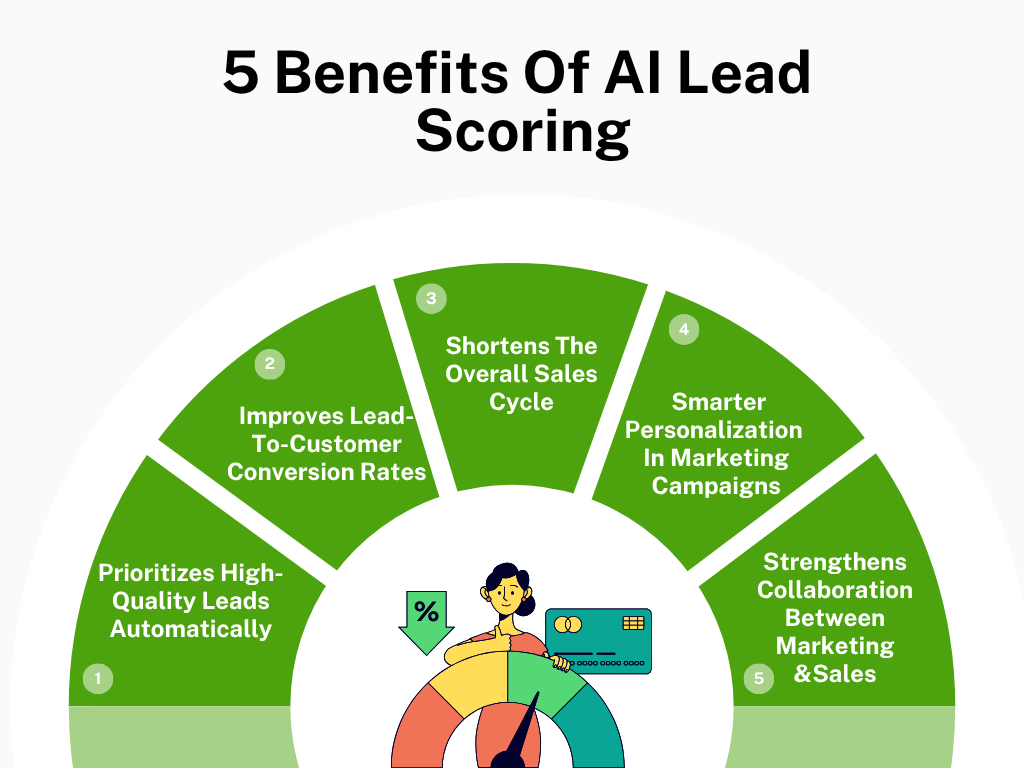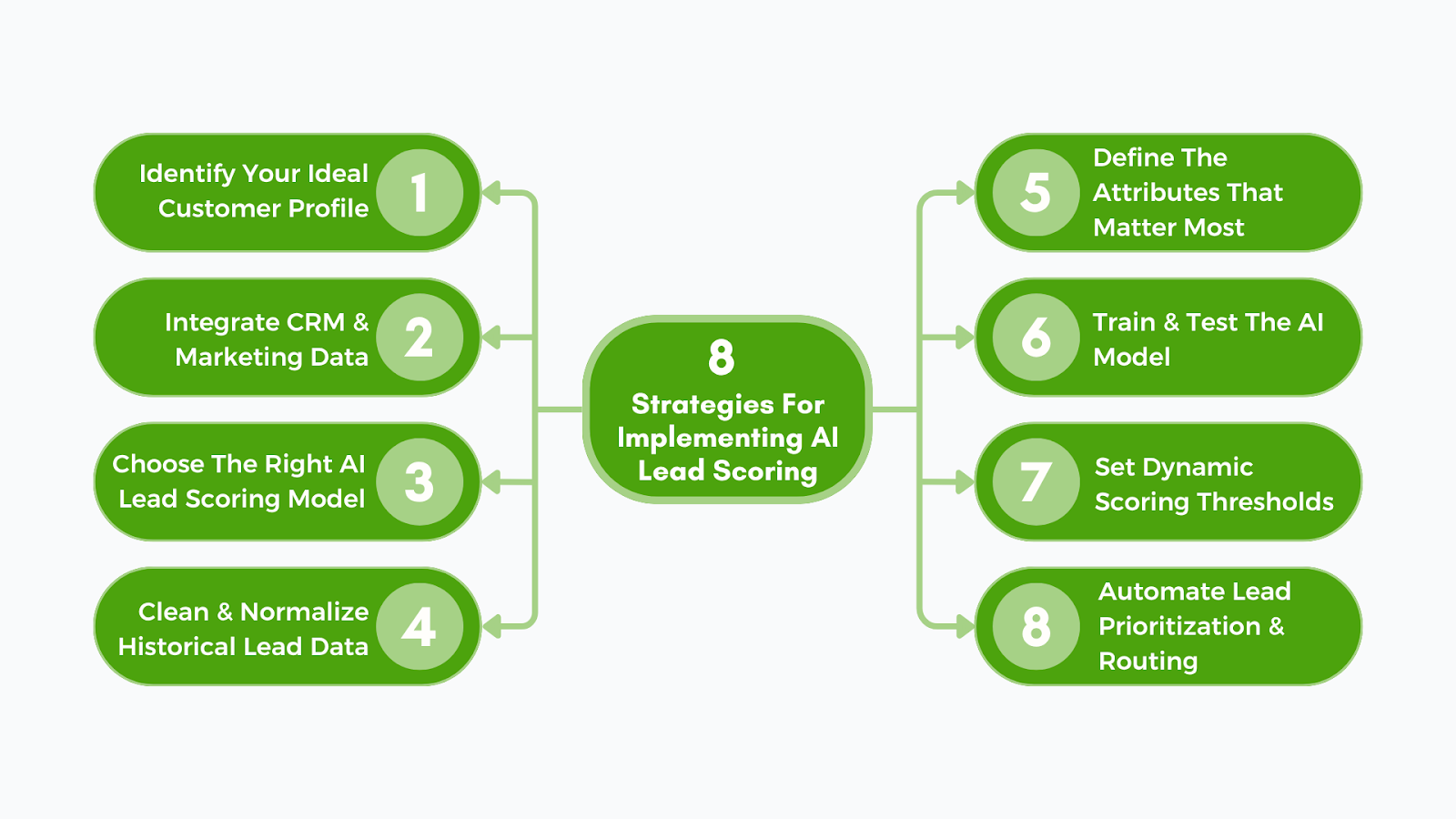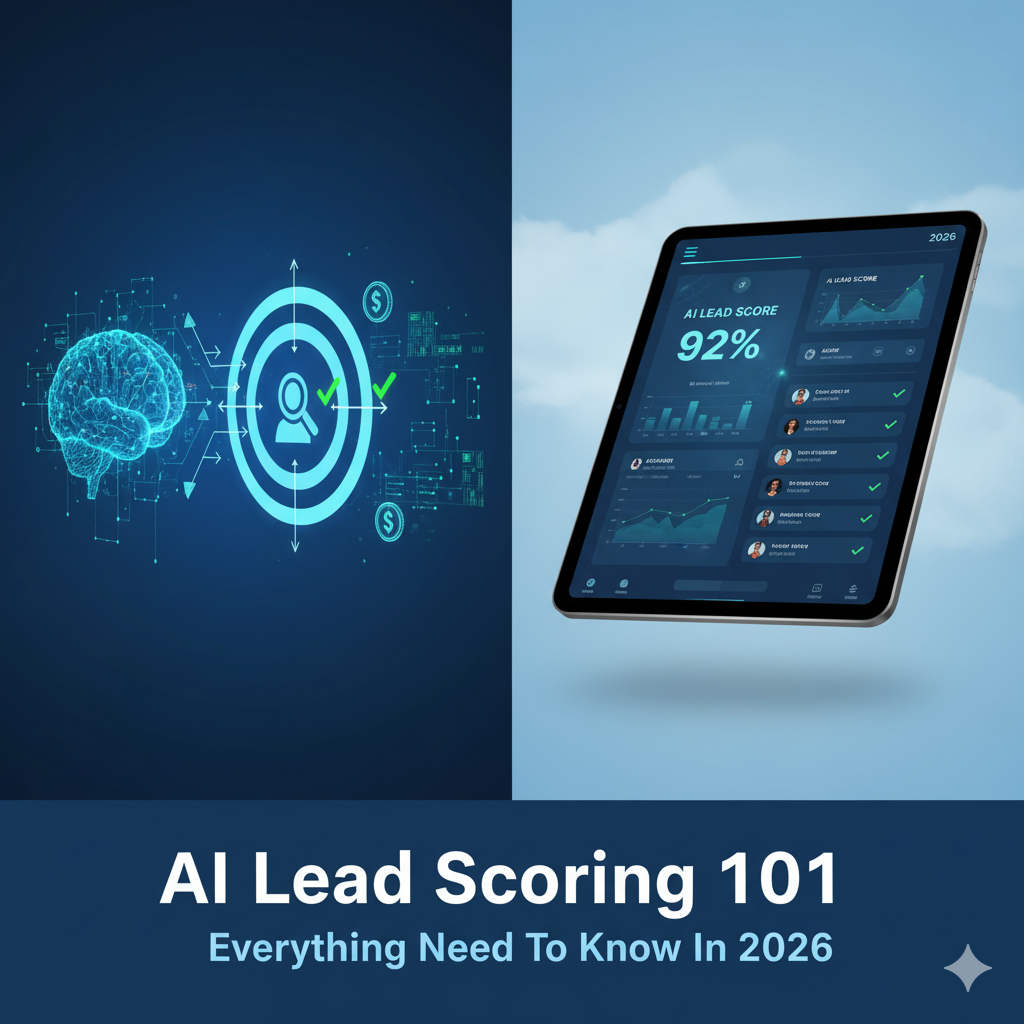You have probably seen it happen – your sales team treating every lead like the deal of the year, while the real buyers walk right by. No, that is not a lead issue – that is a clarity issue. And it is something that only AI lead scoring can fix by giving every lead a story actually worth following.
Sounds like something your sales team needs? We thought so. In this guide, we will explain what AI lead scoring is and how it differs from traditional lead scoring. Plus, we will give you 10 implementation strategies so you can move toward people already halfway to a “yes.”
What Is AI Lead Scoring?

AI lead scoring is a data-driven way to figure out which leads are most likely to become customers. AI looks at all the information you already have about your leads:
- Demographics
- Engagement history
- Lead behavior on your site
- Email activity
- Past conversion trends
It then automatically identifies which of those factors actually matter when it comes to predicting conversions.
Unlike traditional scoring methods that rely on preset rules (like “+10 points if they open an email”), AI adjusts itself continuously. As more leads convert (or don’t), it learns from those outcomes to improve the accuracy of future predictions.
AI Lead Scoring vs. Traditional Lead Scoring: Understanding The Differences

Here’s how AI lead scoring compares against the old-school way.
1. Lead Scoring Process
AI Lead Scoring: It doesn’t wait for someone to assign points. It studies what is working in your pipeline – who buys, who ghosts, who just browses. It then builds its own logic from there and scores leads based on real engagement patterns that evolve every day.
Traditional Lead Scoring: It works off a template. Someone decides that “job title = 10 points” and “form fill = 5 points,” and that is it. This lead scoring system can’t learn or adapt unless someone updates the rules by hand.
2. Accuracy Growth Over Time
AI Lead Scoring: The more data it sees, the sharper its lead scoring criteria becomes. It uses machine learning algorithms to compare new leads to past deals and picks up subtle signs – like response speed or content sequence – for accurate lead scoring.
Traditional Lead Scoring: It gets dull with age. Once built, it just repeats the same scoring logic until someone rechecks it. What had people saying yes last quarter might already be outdated.
3. Behavior & Intent Handling
AI Lead Scoring: It knows when a lead is just curious versus genuinely ready. Someone reading a pricing page 3 times weighs more than 10 blog clicks. It interprets intent, not just activity.
Traditional Lead Scoring: It gives the same weight to everything. A whitepaper download and a demo request might both get 10 points, even though one means interest and the other means purchase intent.
4. Scalability & Data Management
AI Lead Scoring: Whether you have 100 or 100,000 leads, it keeps up. The system processes every new data point in real time without anyone needing to clean or rescore manually.
Traditional Lead Scoring: It slows down fast. More leads = more maintenance and more risk of outdated scores clogging up your CRM.
5. Impact On Sales Team Confidence
AI Lead Scoring: Reps trust it because the AI lead scoring performance lines up with real results. They see closed deals match high scores and learn to move faster.
Traditional Lead Scoring: Reps question it all the time. Scores feel random and mismatched, so people start ignoring them and go back to following hunches on who to chase.
5 Proven Benefits Of AI Lead Scoring

Once AI lead scoring is in place, you start noticing these 5 real, measurable shifts:
1. Prioritizes High-Quality Leads Automatically
AI constantly reshuffles your leads in the list based on fresh behavioral data. Let’s say a prospect ignored your emails for weeks, then suddenly spent 10 minutes on your pricing page – AI notices that spike instantly and moves them to the top.
Your reps don’t have to check dashboards all day or rely on spur-of-the-moment decisions. The system keeps your pipeline focused on people who are active right now, not the ones who looked good a month ago.
2. Improves Lead-To-Customer Conversion Rates
Because your team’s time goes to warmer leads, conversion rates increase. AI learns from past deals – which actions led to revenue, which didn’t. It then keeps refining the scoring logic automatically to prioritize leads worth pursuing.
It spots micro-signals like multiple visits from the same company or a prospect rewatching a demo. Those tiny moments usually slip past humans, but AI connects them to actual sales outcomes. The result – more closed deals without increasing outreach volume.
3. Shortens The Overall Sales Cycle
AI lead scoring solutions give reps a head start. When they open their CRM, they already know who is serious and who is just browsing. That means faster outreach and quicker follow-ups. Rather than taking weeks to realize a lead isn’t moving, reps know within days where to stay on it or let go. Over time, this trims days, sometimes weeks, off the average deal cycle.
4. Enables Smarter Personalization In Marketing Campaigns
AI doesn’t just score leads; it explains why they scored that way. That context gives marketing teams gold-level insight. If the AI lead scoring platform shows that decision-makers respond best to ROI-focused content while managers engage with “how-to” pieces, marketing can adjust timing and message instantly.
Instead of sending generic campaigns, they start talking with intent in mind. Personalization stops sounding fancy and starts showing results – more clicks, better replies, higher relevance. That helps you scale without overspending.
5. Strengthens Collaboration Between Marketing And Sales Teams
AI brings both sales and marketing teams onto the same page – literally. Marketing sees which campaigns attract high-scoring leads. Sales sees why those leads scored high and how they interacted before the first call.
Finger-pointing about “bad leads” or “slow follow-ups” stops. Everyone in the sales and marketing is aligned and is working off the same data source that is updated in real time. Over time, strategy meetings change into planning sessions instead of blame sessions, and sales and marketing efforts start yielding results.
How To Implement & Use AI Lead Scoring: 8 Strategies To Maximize Conversions

Implementing AI lead scoring is exciting – until you realize there is a big difference between “installing it” and “actually using it to close more deals.” These 8 strategies will walk you through the real process.
1. Identify Your Ideal Customer Profile (ICP) Before Training The Model
AI can’t invent your ideal buyer from thin air. If your Ideal Customer Profile (ICP) is fuzzy, your model learns garbage. So before you even touch a dataset, get brutally clear about who actually buys and what they buy.
What To Do:
- Start with real deals. Pull your last 50–100 won deals and note what they had in common – company size, industry, revenue, tech stack, deal size, decision-maker role.
- Look at bad fits too. Study leads that wasted sales time or never converted. Those are patterns your AI should ignore.
- Document your “sweet spot” – mid-size SaaS companies (50–500 employees), using Salesforce, headquartered in North America, buying for a 6–12 month cycle.
- Feed this definition into your model’s parameters so it learns what a qualified customer actually is.
- Revisit your ICP every quarter as your product and buyer evolve.
Now, if you are a two-sided business where you are serving very different audiences at once, it becomes all the more important. Sellers might care about quick turnaround and accuracy, while buyers might be worried about budget and data protection. If your AI model treats both sides as one audience, it will skew your entire scoring logic.
A perfect real-world example of how to handle this is BusinessForSale. They have made this balancing act look easy by building two unique ICPs – one for business owners looking to sell and another for buyers actively searching for opportunities.
On the seller side, their onboarding flow collects data about business category and asking price to help their system understand who is ready to list. On the buyer side, it captures search behavior and saved listings to identify who is most likely to make a purchase.
Because of this clear ICP separation, their AI doesn’t confuse activity with intent. It knows exactly what matters for each audience – urgency for sellers, buying readiness for buyers. That is the foundation you need before training any AI lead scoring model – distinct ICPs that reflect real-world motivations, not a generic profile.
2. Integrate CRM & Marketing Data For Unified Lead Insights
AI can’t score properly if your data is in silos. Your CRM shows pipeline stages, but your marketing tools hold engagement signals. Combine them, or your model sees only half the story.
What To Do:
- Connect your CRM (Salesforce, HubSpot, etc.) and marketing tools (Marketo, ActiveCampaign, etc.) through APIs or native integrations.
- Sync historical data, not just new leads. The model needs to see old campaigns, conversion paths, and engagement histories.
- Match IDs across systems. “John Smith” in one platform should map to “jsmith@company.com” everywhere.
- Include behavioral signals. Page visits, downloads, webinar attendance, and email replies all impact buying intent.
- Randomly pick a few leads and verify their timeline looks identical across systems. If not, fix your sync logic.
Bonus Tip: When pulling paid campaign data, always use verified agency ad accounts. They give you access to full-funnel performance data without API limitations or sampling. This ensures your AI lead scoring model trains on complete and accurate engagement data instead of partial metrics that miss true buyer behavior.
3. Choose The Right AI Lead Scoring Model For Your Sales Cycle
Not every model suits every business. Some cycles rely on deep relationships and multiple decision-makers. Others move fast with trial signups and instant demos. The model you choose should reflect that rhythm.
What To Do:
- If your sales cycle is short (days or weeks), go for a behavioral model. It ranks leads based on recency and intensity of actions.
- If your sales cycle is long (months), use a predictive lead scoring software. It learns from past deals to predict which new leads will close.
- Test both. Run both AI lead scoring tools on the same set of leads and see which one matches real conversions better.
- Involve your sales team. Ask which factors matter most in real-world lead qualification – models perform better when built around human input and sales strategy.
- Start simple. Add new variables only if they actually improve prediction accuracy.
4. Clean & Normalize Historical Lead Data For Accuracy
Most teams underestimate this part. Dirty data ruins models faster than bad logic. If you have missing values or outdated records, your scores will be garbage, no matter how advanced your algorithm is. You need consistency before intelligence.
What To Do:
- Merge multiple records for the same person or company.
- Standardize fields. Job titles like “Marketing Manager” and “Head of Marketing” should be normalized into one label.
- Trim the fat from your dataset. Leads with fake emails or no engagement history don’t help your model learn anything useful.
- Backfill missing information. Use Clearbit or ZoomInfo to enrich data.
- Keep a cleaning schedule. Automate this monthly so your AI always trains on current and reliable performance data.
5. Define The Attributes That Matter Most For Conversion Probability

AI can process thousands of signals, but it still needs a starting point. Your job is to find out which traits separate buyers from browsers – and make those your core scoring inputs.
What To Do:
- Pull past deal data and run correlation analysis. See which attributes keep showing up in successful deals.
- Bucket your variables into:
- Demographic – job title, region, company size
- Firmographic – industry, tech stack, revenue
- Behavioral – time on pricing page, webinar attendance, replies
- Cut irrelevant data. If “social media follows” or “page visits” don’t link to conversions, remove them.
- Prioritize the top 10–15 attributes. Don’t overfeed the model – more data isn’t always better.
- Document attribute logic. So if your reps ask, “Why is this lead ranked 92?” you can actually explain it.
When you sell expensive products, your conversion logic can’t be treated like a generic eCommerce funnel. Price changes everything – the decision cycle is slower, and buyers compare endlessly. You can’t just rely on broad signals like “time on site” or “email opens.” That is why defining your conversion attributes needs extra precision.
A great real-world example is IceCartel, a brand that sells premium jewellery. They have built their conversion logic around high-intent behaviors. Their AI-backed system tracks detailed attributes like preferred carat size, metal type, viewing time per product, and frequency of price-filter use.
It even weighs repeat visits to the same item more heavily than broad browsing. Over time, that helps their AI identify buyers who are genuinely evaluating a purchase versus those casually exploring.
That is how high-value brands should approach attribute definition – by focusing on the specific actions that prove commitment, not generic engagement.
6. Train & Test The AI Model Using Past Sales Outcomes
Your AI model learns from every yes and every no along the way. You feed it your cleaned and labeled data, it studies past deals and builds a pattern of what converts. Then you test whether that logic holds up on unseen data.
What To Do:
- Train your model on at least 12 months of data. You want seasonality and campaign variations included.
- Pull real-world sales calls or demos from YouTube using a reliable video downloader and feed their transcripts into your analysis. Those conversations help you catch tone and buying signals that your CRM data alone can’t show.
- Split your dataset. Use 80% of your leads for training, 20% for testing.
- Label outcomes. Mark leads as “won,” “lost,” or “disqualified.” These tags help the AI learn what is worth chasing and what is a dead end.
- Run the model and compare predicted scores vs. real outcomes. If your top 20% scored leads match actual deals, you are on track.
- Check false positives. Leads that score high but never buy. Find out why these unqualified leads are misleading the model.
7. Set Dynamic Scoring Thresholds Based On Real-Time Engagement
Static scoring rules are outdated the moment your market changes. If a new campaign spikes engagement or a certain region starts converting faster, your thresholds should shift automatically.
What To Do:
- Build engagement triggers that instantly refresh lead scores. Like 3+ site visits in 24 hours or a new demo request.
- Define your scoring buckets – 80+ = Hot, 50–79 = Warm, below 50 = Cold.
- Let AI adjust thresholds weekly based on real conversion patterns.
- Track changes visually. Use dashboards to see how lead distribution moves as campaigns run.
- Connect a mass notification system to your setup for alerting your team instantly. That way, if a lead crosses from “warm” to “hot,” everyone who needs to move gets the notification simultaneously. It keeps response times under minutes instead of hours and stops hot leads from cooling off because someone missed an update.
8. Automate Lead Prioritization & Routing Using AI Scores
AI scoring only matters if it triggers action. Don’t let most promising prospects sit in limbo waiting for someone to notice them. Routing automation gets your best opportunities to the right people instantly.
What To Do:
- Set routing rules. Leads scoring above 80 go directly to SDRs within 5 minutes; 50–79 enter an automated follow-up email flow.
- Distribute based on rep strength. Assign big accounts to senior reps – fast-moving ones to high-volume reps.
- Use notifications. A Slack or CRM alert should fire the moment a “hot” lead appears.
- Track response times. The shorter the follow-up window, the higher your conversion rate – aim for under 10 minutes.
- Review automation logs. Check weekly that routing isn’t skipping or duplicating leads.
5 Common AI Lead Scoring Mistakes & How To Fix Them

AI-powered lead scoring works great – until you overthink or undercheck it. Here’s what usually goes sideways – and exactly how to fix it.
1. Overcomplicating The Model With Too Many Variables
The first mistake everyone makes is adding everything they can find into the model — job titles, email opens, form fills, webinar attendance, social follows, time on site, even location data.
It feels “thorough,” but all it does is create confusion. The model ends up handling hundreds of buying signals that don’t actually predict anything. It confuses your logic and produces scores that reps stop trusting.
How to Fix:
Strip it back to the essentials. Focus on 10–15 attributes that directly correlate with closed deals. If a variable doesn’t clearly affect conversion rates, drop it. The simpler the model, the faster it learns and the easier it is to trust.
2. Ignoring Data Bias That Skews Your Lead Predictions
Your AI doesn’t know what’s “fair.” It just mirrors your history. If your old data is packed with leads from one industry or region, the model will keep chasing the same type. That is how you end up missing new markets or buyers who don’t fit your past mold but are ready to buy now.
How to Fix:
Audit your training set for diversity. Make sure it includes a balanced mix of deals. If you have recently expanded into new markets, add recent leads and wins from those segments before retraining.
3. Neglecting To Revalidate The Model After Major Market Shifts
Markets change faster than most models get updated. A new competitor enters, buying cycles shorten, budgets shrink – and suddenly, what used to define a “qualified lead” no longer fits. If you are not retraining or testing your model after these shifts, it will keep scoring based on logic that is already outdated.
How to Fix:
Revalidate your scoring model every quarter – or immediately after major internal or market changes. Run a side-by-side comparison of your current model’s most promising leads versus actual deals closed in the past 90 days. If the correlation drops, it is time to retrain.
4. Relying Solely On AI Scores Without Human Oversight Or Context
AI should guide decisions, not replace judgment. When teams start treating scores as gospel, they stop thinking critically. You will see reps ignoring promising leads just because they ranked “low” or over-prioritizing those that scored high for the wrong reasons.
How to Fix:
Set up a regular feedback cycle between sales reps and your data team. Have reps flag leads where the score didn’t match real-world quality. Feed those examples back into the model as “exceptions” before retraining.
You can also make this whole process smoother by hiring a Revenue Operations Analyst. They sit right at the intersection of data, sales, and marketing — exactly where lead scoring lives and often breaks down.
Their job is to break down what the AI is saying into what the business actually needs. They spot the gaps fast and make sure the next training cycle fixes them. It keeps your AI grounded in reality, and your reps free to sell instead of overthinking the system.
5. Measuring Success Without Comparing It To Pre-AI Benchmarks
Here’s where most teams fail. They launch AI lead scoring, and when they see conversions improving a bit, they assume it is working. But “better” means nothing unless you compare it to how things performed before AI. Without benchmarks, you can’t prove impact or spot when the model is slipping.
How to Fix:
Pull your key metrics from the pre-AI period – conversion rates, average time to close, lead-to-opportunity ratio. Then track the same KPIs after implementing AI. If the gap isn’t growing over time, check your scoring inputs and routing rules.
Conclusion
AI lead scoring isn’t the hero of your sales funnel – it is the mirror. If that reflection looks blurry, it is not the AI’s fault – it is the data or the process.
So, build it simple and never let it run on autopilot. Let your reps challenge it. Let marketing update it. Keep it close enough to your sales floor that it learns the same lessons your people do. That is how AI lead scoring grows into something that genuinely rewires how your team sells.
At Highperformr AI, we have built a system of intelligence behind your go-to-market motion, pulling all the signals so your team doesn’t wait for insights. With over 100 configurable ICP signals, integrations with 60+ platforms, and a database of 54 million companies and 450 million contacts, we have done the plumbing so you can focus on the human part of closing deals.
Sign up for free or book a demo, and we will show you how this actually works in your workflow.






